In the world of audio equipment and turntables, the terms “line” and “phono” often surface when discussing audio inputs and connections. Understanding the difference between these two types of inputs is crucial for setting up a turntable correctly and achieving optimal sound quality. In this comprehensive guide, we will delve into the distinctions between line and phono inputs, their unique characteristics, and their significance in the world of vinyl playback.
Part 1: Line-Level Inputs
1.1 Line-Level Inputs
Line-level inputs, often labeled as “LINE IN” or simply “LINE,” are a standard type of audio input found on amplifiers, receivers, mixers, and various audio equipment. These inputs are designed to accept audio signals that have already been pre-amplified and equalized to a standardized level.
1.2 Characteristics of Line-Level Inputs
- Standardized Signal Level: Line-level inputs receive audio signals at a consistent and standardized level, typically around 0.316 volts (or -10 dBV). This level ensures compatibility with a wide range of audio sources, such as CD players, smartphones, and tape decks.
- No Additional Equalization: Line-level inputs do not apply any specific equalization to the audio signal. They assume that the incoming signal is already pre-equalized and ready for amplification.
- Versatility: Line-level inputs are versatile and can accommodate various audio sources, making them suitable for connecting devices that output line-level signals.
Part 2: Phono Inputs
2.1 Phono Inputs
Phono inputs, often labeled as “PHONO,” are specialized audio inputs exclusively intended for turntables (record players). These inputs are tailored to compensate for the unique characteristics of vinyl records and the signals generated by turntable cartridges.
2.2 Characteristics of Phono Inputs
- Low-Level Signal: Turntables produce a low-level audio signal due to the physical nature of reading the grooves on vinyl records. Phono inputs are designed to receive and amplify this weak signal to a level suitable for further amplification.
- Equalization (RIAA Curve): Vinyl records are recorded with specific equalization curves, such as the RIAA curve, to correct for tonal imbalances during recording and playback. Phono inputs include a built-in phono preamp (phono stage) that applies the necessary equalization to ensure accurate sound reproduction.
- Source-Specific: Phono inputs are source-specific and are exclusively intended for use with turntables. Attempting to connect other audio sources, such as CD players or smartphones, directly to phono inputs will result in incorrect amplification and undesirable sound quality.
Part 3: The Key Differences
Now, let’s clarify the primary differences between line and phono inputs:
3.1 Signal Level
- Line: Line inputs receive audio signals at a standardized and higher level, suitable for amplification without further pre-amplification.
- Phono: Phono inputs receive very weak, low-level audio signals from turntables that require significant pre-amplification.
3.2 Equalization
- Line: Line inputs do not apply any specific equalization to the audio signal and assume that the incoming signal is already pre-equalized.
- Phono: Phono inputs include a built-in phono preamp that applies the necessary equalization, such as the RIAA curve, to correct for tonal imbalances in vinyl records.
3.3 Compatibility
- Line: Line inputs are compatible with a wide range of audio sources, including CD players, tape decks, digital music players, and more.
- Phono: Phono inputs are source-specific and designed exclusively for turntables. They are not compatible with other audio sources without an external phono preamp.
Part 4: Conclusion
In conclusion, the differences between line and phono inputs lie primarily in their signal levels, equalization characteristics, and compatibility with audio sources. Line inputs are versatile and accept standardized, pre-amplified signals, making them suitable for a wide range of audio sources. Phono inputs, on the other hand, are specialized for turntables, amplifying their low-level signals and applying specific equalization to reproduce the unique sound of vinyl records accurately. Understanding these distinctions is essential for configuring your audio equipment correctly and achieving the best possible sound quality when enjoying your vinyl collection.


